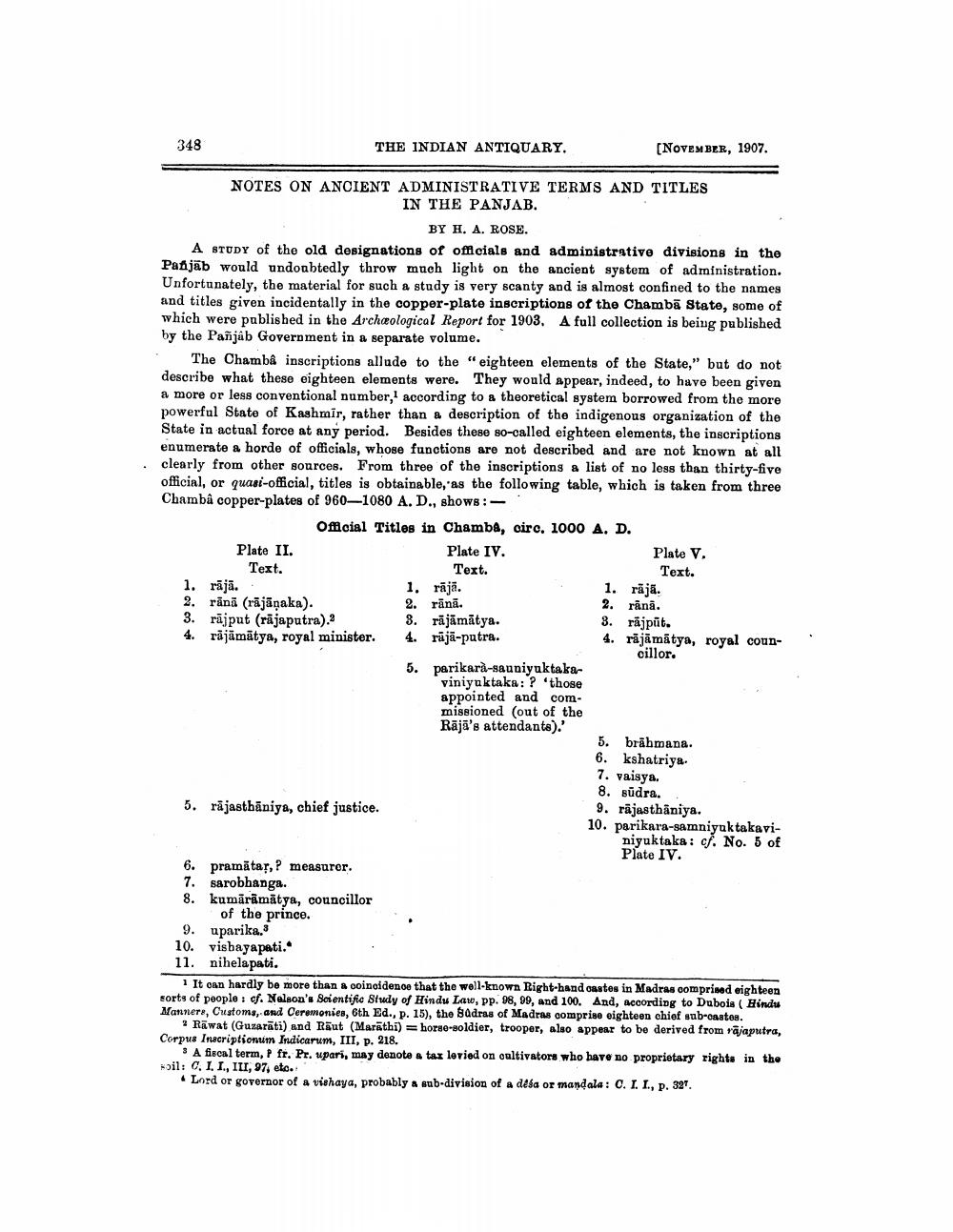________________
348
THE INDIAN ANTIQUARY.
(NOVEMBER, 1907.
NOTES ON ANCIENT ADMINISTRATIVE TERMS AND TITLES
IN THE PANJAB.
BY H. A. ROSE. A STUDY of the old designations of officials and administrative divisions in the Paajab would undoubtedly throw much light on the ancient system of administration. Unfortunately, the material for such a study is very scanty and is almost confined to the names and titles given incidentally in the copper-plate inscriptions of the Chambā State, some of which were published in the Archeological Report for 1903. A full collection is being published by the Pañjab Government in a separate volume.
The Chambé inscriptions allude to the "eighteen elements of the State," but do not describe what these eighteen elements were. They would appear, indeed, to have been given a more or less conventional number, according to a theoretical system borrowed from the more powerful State of Kashmir, rather than a description of the indigenous organization of the State in actual force at any period. Besides these so-called eighteen elements, the inscriptions enumerate a horde of officials, whose functions are not described and are not known at all clearly from other sources. From three of the inscriptions a list of no less than thirty-five official, or quasi-official, titles is obtainable, as the following table, which is taken from three Chambâ copper-plates of 960—1080 A.D., shows:
Official Titles in Chamba, circ. 1000 A. D. Plate II. Plate IV.
Plate V. Text. Text.
Text. 1. rājā.
1. rājā.
1. raja. 2. rānā (rājāņaka).
2. rānā.
2. rānā. 3. rājput (rajaputra).
8. räjāmātya.
8. räjpūt. 4. răjāmātya, royal minister. 4. rājā-putra.
4. räjämätya, royal coun
cillor. 5. parikara-sauniyuktaka
viniyaktaka: ? 'those appointed and commissioned (out of the Rājā's attendants).'
5. brahmana. 6. kshatriya 7. vaisya.
8. sūdra. 5. rajasthāniya, chief justice.
9. rajasthāniya. 10. parikara-samniyuktakavi
niyuktaka: cf. No. 5 of
Plate IV. 6. pramătar, ? measurer. 7. sarobhanga. 8. kumārāmātya, councillor
of the prince. 9. uparika. 10. vishayapati. 11. nihelapati.
It can hardly be more than a coincidence that the well-known Right-hand castes in Madras comprised eighteen sorts of people : cf. Nelson's Scientific Study of Hindu Law, pp. 98, 99, and 100. And, according to Dubois ( Hindu Manners, Customs, and Ceremonies, 6th Ed., p. 15), the Sadras of Madras comprise eighteen chief sub-castes.
? Rāwat (Guzarāti) and Raut (Marathi) horse-soldier, trooper, also appear to be derived from rājaputra, Corpus Inscriptionum Indicarum, III, p. 218.
IA fiscal term, P fr. Pr. upari, may donote a tax levied on cultivators who have no proprietary rights in the Foil: C. II., III, 97, eto.
• Lord or governor of a vishaya, probably a sub-division of a disa or mandala: 0. I. I, p. 327.




